Are you trying to find the ideal vine to climb a pergola or trellis in your yard? When choosing a climbing vine, it’s important to choose the proper one because not all vines make excellent climbers.
Climbers are available in a wide variety of forms and hues. This post features our top picks for vines that can climb your garden’s walls, pergolas, and trellises.
1. Cup and Saucer Vine

Scientific name: Cobaea scandens
Plant Type: Perennial
Plant Size: 30-40 feet
Sun Exposure: Full sun
When grown from seed, this swiftly expanding vine can effortlessly ascend almost its whole length in a single growing season. It may not flower at all or very poorly in its first year. The plant will expand as far as you let it, throwing a thick layer of oblong, bright green leaves over trees and fences.
Before opening into a cup shape and turning purple or white with a lovely, honey-like perfume, the flowers are a pale green colour and have an unpleasant smell. As long as it has somewhere to climb, this plant is one of the few blooming vines that thrive in containers.
2. False Hydrangea Vine

Scientific name: Schizophragma hydrangeoides
Plant Type: Perennial
Plant Size: 40-50 feet
Sun Exposure: Full Sun to Partial shade
This vine can grow in practically any amount of sunlight or shade, but it needs at least filtered sunlight to blossom. It can be harmed by too much sun, particularly in warm climates. Winter pruning promotes quicker spring growth.
This vine, also known as the Japanese Hydrangea rose sensation, will climb and spread as far as you let it. It is a wonderful choice for covering trellises, fences, or anything else you wish to hide because it produces little pinkish-red flowers during the majority of the summer.
3. Madagascar Jasmine

Scientific name: Stephanotis floribunda
Plant Type: Perennial
Plant Size: 10-15 feet
Sun Exposure: Partial sun
The Madagascar jasmine grows slowly, reaching a maximum height of approximately 15 feet. Clusters of small white tubular blooms in the shape of stars are framed by leathery, dark green foliage.
In all zones, it grows nicely in containers. However, overwinter this plant indoors or in a greenhouse to avoid frost in cold locations where the temperature falls below 40 degrees Fahrenheit.
The fragrant little white blossoms of this vine are also known as the Hawaiian wedding flower or bridal wreath, and they are often seen in bridal bouquets. Cool temperatures cause the plant to develop slower and produce fewer blooms.
4. Moonflower

Scientific name: Ipomoea alba
Plant Type: Perennial
Plant Size: 10-15 feet
Sun Exposure: Full sun
The huge white blossoms of the moonflower, which open at night, bring appeal to any garden in the middle of summer. Although it is perennial, colder areas allow it to be cultivated as an annual. It has few diseases or pests and is harmful to humans and animals, just like many other blooming vines.
Every night after dark, the blooms open and produce a delightful smell. In certain warmer climates, such as the southern US and Hawaii, it is listed as an invasive plant. These can also be grown in hanging planters or as a ground cover.
5. Snowdrift Clematis

Scientific name: Clematis armandii ‘Snowdrift’
Plant Type: Perennial
Plant Size: 10-25 feet
Sun Exposure: Partial to full sun
This fragrant little white flowering evergreen vine blooms in April and May and has dark green foliage that covers trees and fences all year long.
Although this species, like many others, is not good for container planting, clematis vines are known for their rapid ascent.
With its ability to spread up to 30 feet in width, this plant is a great way to cover a fence or conceal an unsightly object in the yard. It’s a good vine for novice gardeners because it’s resistant to pests and drought.
6. Zephirine Drouhin Climbing Rose
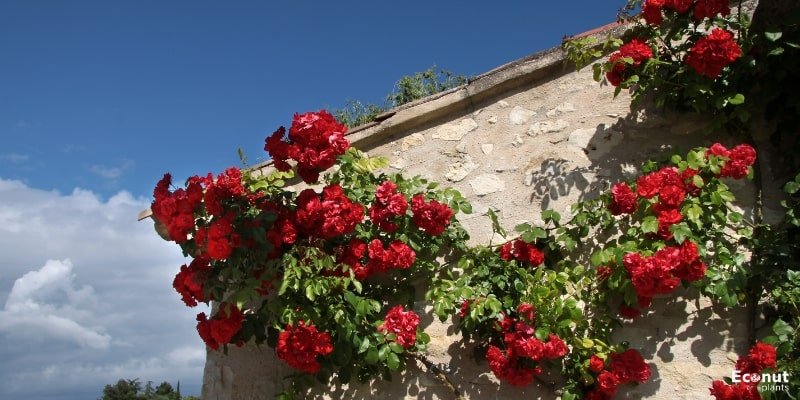
Scientific name: Rosa ‘Zephirine Drouhin’
Plant Type: Perennial
Plant Size: 15-20 feet
Sun Exposure: Partial to full sun
This rose has stunning, deep pink flowers that give the impression of requiring a lot of labour. As long as you monitor potential pests and illnesses, the vine grows well in any type of soil and tolerates climbing.
This thornless rose thrives in warm climates in full sun when it produces its traditional 4-inch blooms. The vine can be trimmed like a shrub if you don’t want it to climb; it will continue to produce dozens of blossoms from July through September. A Bourbon rose with a unique sweet aroma evocative of raspberries is the Zephirine Drouhin rose.
7. Summer Jazz Fire Trumpet Vine
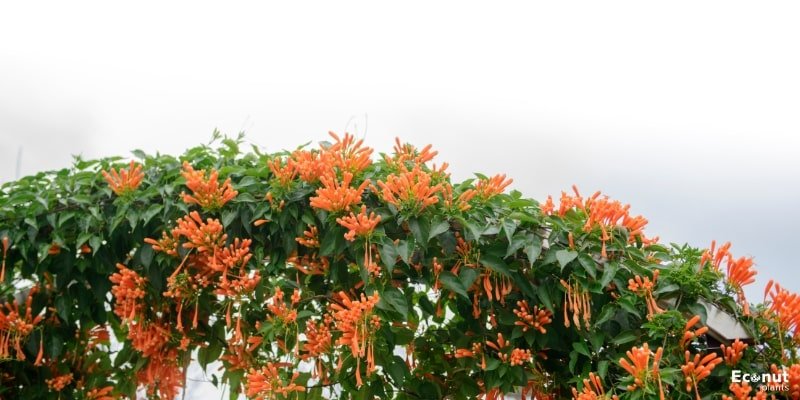
Scientific name: Campsis x tagliabuana
Plant Type: Perennial
Plant Size: 4-7 feet
Sun Exposure: Full sun
This little vine has rich red, trumpet-shaped blooms with orange throats that bloom from early summer to late autumn. No matter where you train it to climb, this trumpet vine will still make a statement, even though it won’t grow very tall. It works well as a container plant as well.
Once it takes root, the vine doesn’t need constant watering and grows quickly. Hummingbirds and butterflies are drawn to the tubular flowers, but if the plant doesn’t receive enough sunlight, they won’t bloom.
8. New Dawn Climbing Rose
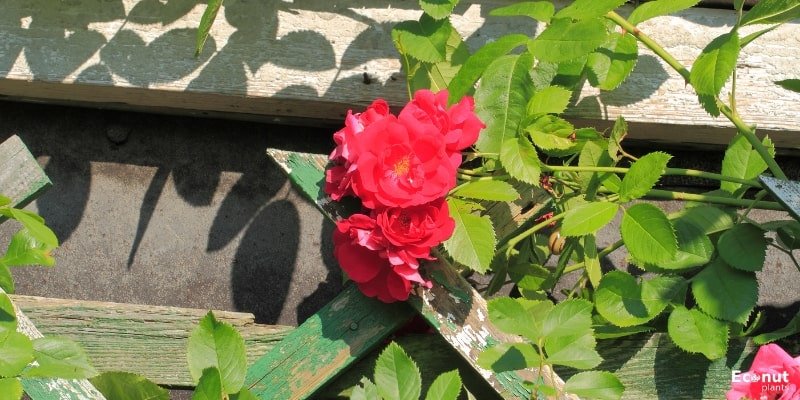
Scientific name: Rosa rubiginosa
Plant Type: Perennial
Plant Size: 10-15 feet
Sun Exposure: Partial to full sun
This rose type climbs quickly, has medium-sized, delicate pink flowers that last all summer if you fertilize it properly, and waxy, dark green foliage. The 3-inch blooms give your landscape colour and depth since they are densely packed with dozens of petals.
This rose was developed in 1930 by Somerset Rose Nursery in New Jersey. It is resistant to pests and diseases and can climb to cover an arbour or trellis in a single growing season.
9. Rebecca Clematis
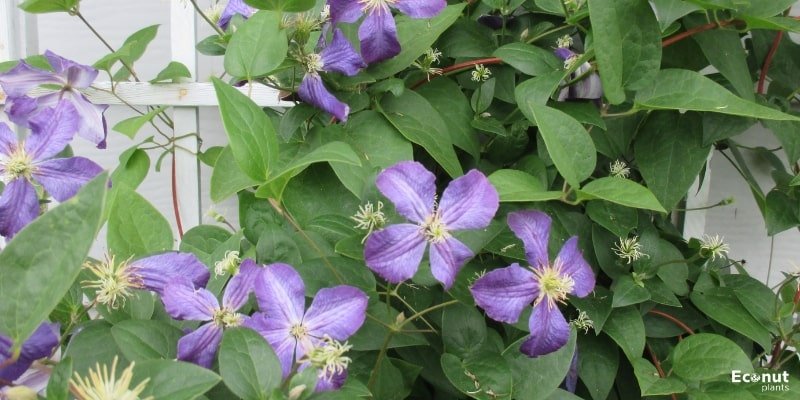
Scientific name: Clematis ‘Rebecca’ evipoo16
Plant Type: Perennial
Plant Size: 6-8 feet
Sun Exposure: Partial to full sun
While they are not the tallest trellis-climbing vines, clematis vines have some of the most vivid and striking blossoms of any blooming plant. Some of a summer garden’s darkest crimson blooms can be found on this one. The maximum diameter of each blossom is 8 inches.
The flowers start to bloom in late spring or early summer and continue until the beginning of autumn. The hues of the flowers on this vine vary from a deep crimson to a dark purple.
If there’s space for this clematis to climb, it grows nicely in containers; alternatively, you can clip it to maintain its shrubby shape.
10. Mandevilla Alice du Pont

Scientific name: Mandevilla x amabilis
Plant Type: Perennial
Plant Size: 10-15 feet
Sun Exposure: Partial shade to partial sun
Attractive to hummingbirds and butterflies, the large, trumpet-shaped flowers have deep pink throats and pale pink petals. In warmer climates, the plant can be grown as an annual, but in cooler climates, it is an evergreen.
With blossoms that appear from summer to autumn, the vine multiplies in a matter of weeks and is quite manageable. Warmer conditions allow it to flower in April. Covering arbours, fences, and trellises, the leathery leaves provide a deep green carpet.
11. Hyacinth Bean

Scientific name: Lablab purpureas
Plant Type: Annual
Plant Size: 10-20 feet
Sun Exposure: Partial to full sun
This vine grows quickly and yields dramatic-looking deep purple seed pods and bracts of shell-shaped purple flowers for decorations. When the pods are young, they can be eaten in modest quantities.
The vine produces a dense blanket of big leaves, making it a great choice to weave around a trellis or arbour to offer shade. Allow the seed pods to dry on the vine in the autumn, and then store them for the winter in a dry area so you may plant them in the spring.
12. Golden Bell Clematis
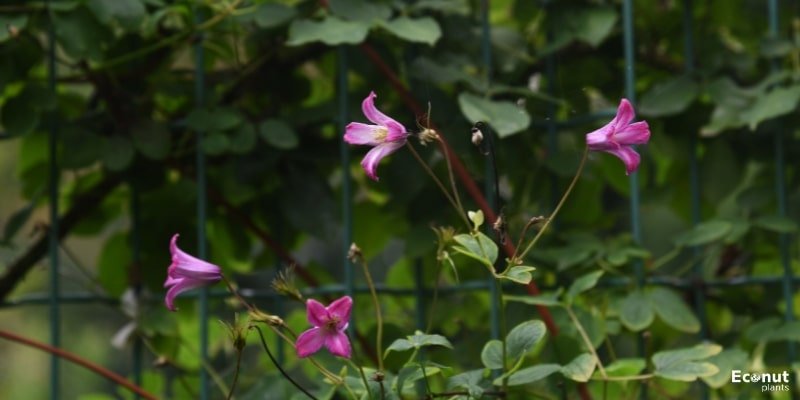
Scientific name: Clematis tangutica
Plant Type: Annual
Plant Size: 6-8 feet
Sun Exposure: Partial shade to full sun
This clematis cultivar, sometimes called the “Orange-Peel Clematis” and the “Old Man’s Beard Clematis,” blooms with bell-shaped, hanging flowers in early summer, typically in early June, and continues to put on new buds until the end of October.
Typically, the little golden-yellow blossoms are smaller than two inches in size. One of its names comes from the blooms becoming fluffy hanging pods that resemble beards as they go to seed. Several late-summer and early-fall floral compositions feature the pods.
Although this clematis draws butterflies, it is extremely poisonous to humans and animals, so keep it out of their reach. Little ones who come into contact with the plant run the risk of being severely poisoned if they put their fingers in their mouths or get skin irritations from the sap.
13. Firecracker Vine
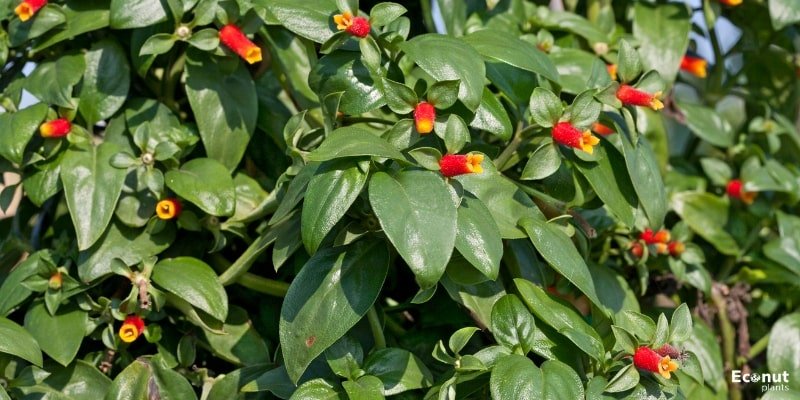
Scientific name: Ipomoea lobata
Plant Type: Perennial
Plant Size: 10-16 feet
Sun Exposure: Full sun
This vine, often known as the Spanish Flag, grows best in direct sunlight. It does well in partial shade but yields fewer flowers.
The tubular flowers stand out from the stems and grow the same length in crimson that fades to pale yellow, creating a lovely gradient that adds drama to a garden. The three-lobed leaves can grow up to six inches long.
In July, blooms start to develop and last until the first frost. It’s among the greatest vines to plant to attract hummingbirds and butterflies.
14. Sweet Summer Love Clematis

Scientific name: Clematis ‘Sweet Summer Love’
Plant Type: Perennial
Plant Size: 10-15 feet
Sun Exposure: Partial to full sun
This vine grows quickly and is among the toughest members of the Clematis family. The second growing season should yield an abundance of fragrant blossoms from July until mid-September, but don’t expect star-shaped flowers the first year.
As they grow on the shrub, the red blossoms eventually become purple. As long as you provide it with a trellis or other climbing support, you can grow this vine in a container.
15. Virginia Creeper

Scientific name: Parthenocissus quinquefolia
Plant Type: Perennial
Plant Size: 30-50 feet
Sun Exposure: Partial shade to full sun
Virginia creeper vines have green, inconspicuous blooms that bloom in June and July. You won’t, however, miss the blossoms because this vine’s leaves are truly its main attraction. Its leaves have five points and are bright green in the summer, but when the weather cools down in late autumn, they become a striking scarlet.
This vine’s aerial roots enable it to climb smooth surfaces like walls, but it also looks good when coiled around an object or used as a ground cover that spreads quickly. Growing it is simple, even for inexperienced gardeners. While animals consume the berries, humans can die from them due to their high toxicity.
16. Scentsation Honeysuckle

Scientific name: Lonicera periclymenum
Plant Type: Perennial
Plant Size: 8-10 feet
Sun Exposure: Full sun
You may teach this excellent climber, which resembles a honeysuckle shrub, to climb almost anything. Blooms of a rich yellow and white smell develop in the spring and continue throughout the late summer. Subsequently, scarlet berries replace the blossoms in the autumn.
Though this vine, like most honeysuckle variants, isn’t invasive and won’t eat other plants, it still draws hummingbirds.
While certain types of honeysuckle vines can overpower adjacent plants, this particular species provides a similar delightful scent without interfering with adjoining development.
17. Morning Glory
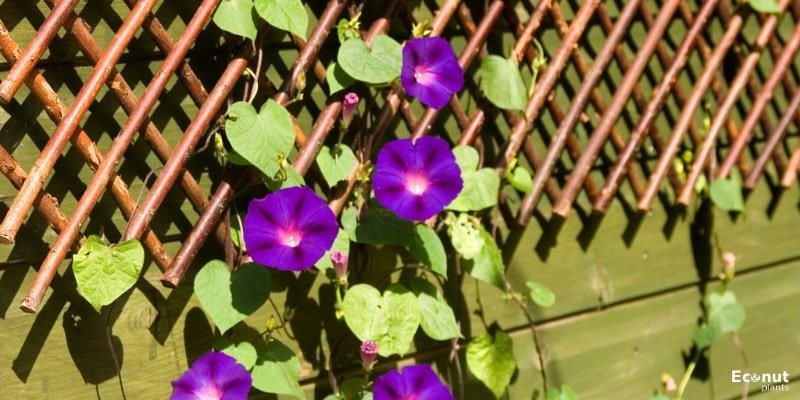
Scientific name: Ipomoea purpurea
Plant Type: Annual
Plant Size: 10-12 feet
Sun Exposure: Full sun
One of the flowering vines that most gardeners grow is the morning glory since it requires minimal maintenance and adds beautiful colour to any garden. It’s an easily trained climber that grows quickly, and it’s a breeze to start from seed outside.
Despite not being a genuine perennial, the vine typically self-seeds and comes back every year. Early autumn or midsummer sees the appearance of trumpet-shaped flowers.
Deep purple blossoms, multicoloured blooms, or deep red petals are among the variations to pick from. Both humans and pets should avoid handling the flowers, leaves, and stems.
18. Jewel of Africa Nasturtium
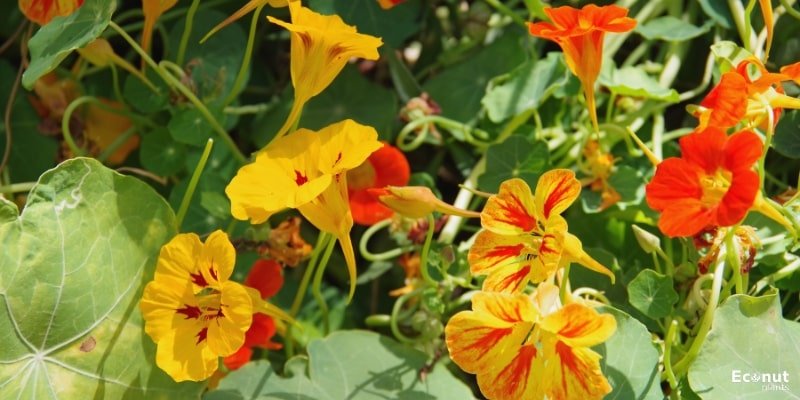
Scientific name: Tropaeolum majus
Plant Type: Annual
Plant Size: 6-10 feet
Sun Exposure: Full sun
This vine produces flowers with classic fall hues including orange, yellow, and dark red, as well as paler tones like cream and pinkish-orange. The leaves have white lines that vary in colour from bright green too.
This vine has edible leaves and blooms, in contrast to many others. Fragrant blooms with several colours emerge from mid-summer to early autumn. By late autumn, you can grow from a seed started in early spring to a height of roughly 10 feet.
This nasturtium is a favourite food of caterpillars, so expect plenty of chewed leaves and stems. Aphids are often an issue with it.
19. Highwire Flyer Climbing Rose

Scientific name: Rosa spp
Plant Type: Perennial
Plant Size: 6-8 feet
Sun Exposure: Partial to full sun
This rose blooms in many hot pink clusters that continue into early autumn. The rose is more disease-resistant than certain strongly fragrant breeds, but it doesn’t smell as intense as other variations. Unlike other roses, this one is resistant to black spots, mildew, and mold.
Although it’s not the tallest climbing trellis-blooming vine, it’s one of the most beautiful due to its vivid colour and big clusters of blooms.
20. Empress Eugenie Passion Flower Vine
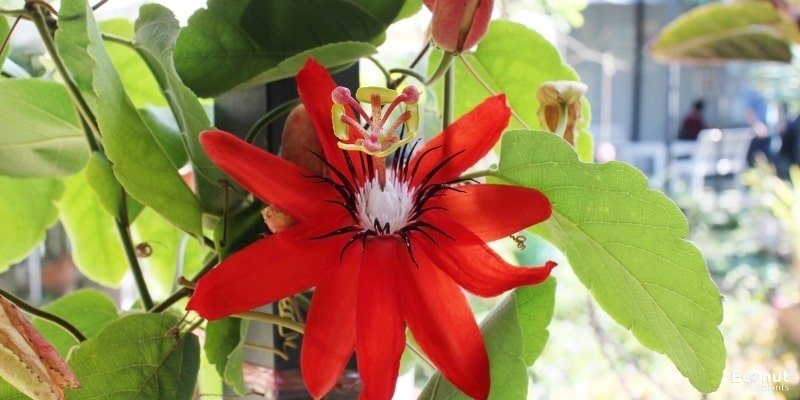
Scientific name: Passiflora x belotii
Plant Type: Perennial
Plant Size: 20-30 feet
Sun Exposure: Partial shade to full sun
The blossoms on this vine are remarkably tactile, multicoloured, and almost alien-looking. Thick green stamens envelop darker purple feathery petals set against a background of white to purple petals.
The flower is multicoloured and patterned in every area. Despite being difficult to grow, the vine adds drama and fragrance to a garden. When it does establish itself and flower, it attracts butterflies and birds.
21. Blue Moon Kentucky Wisteria

Scientific name: Wisteria macrostachya
Plant Type: Perennial
Plant Size: 15-25 feet
Sun Exposure: Full sun
This plant is an example of a trellis climbing vine that is simple to grow yet produces striking effects. Vines of light- to dark-coloured lavender flowers bloom in clusters during late spring and again in the summer.
The deep and pleasant aroma makes sure that everyone in the vicinity will be able to smell the flowers. Kentucky wisteria is an even more lovely addition to a yard or garden since it also draws butterflies.
Although the vines can grow up to 25 feet and spread out as wide as 8 feet in the first year or two, new plantings may not blossom until their third spring.
22. Carolina jessamine

Scientific name: Gelsemium sempervirens
Plant Type: Perennial
Plant Size: 10-20 feet
Sun Exposure: Partial shade to full sun
One of the floral vines that grow wild in the southern United States is this evergreen shrub. It’s among the simplest vines to grow in containers with adequate water or the ground.
The Carolina jessamine, sometimes referred to as the “Evening Trumpet flower” and the “Poor Man’s Rope,” is the official flower of South Carolina.
It’s a great climber, but it can also be used as a ground cover. The deep yellow and golden trumpet-shaped flowers start to blossom in late April and appear in February. Although some tendrils may get top-heavy and require occasional cutting, overall, this plant requires little care.
23. Bougainvillea

Scientific name: Bougainvillea
Plant Type: Perennial
Plant Size: 10-40 feet
Sun Exposure: Full sun
Bougainvillaea plants are flowering vines that, in the correct conditions, produce brightly coloured bracts that resemble trumpets and contain a little bloom inside from May to December.
As soon as the plant takes root properly, it becomes a low-maintenance, fast-growing vine that can climb any wall, fence, or trellis as long as it has something to twine around. To keep the vine contained and encourage brighter, more numerous bracts, routine trimming is the only maintenance needed.
24. Apple Blossom Clematis

Scientific name: Clematis armandii ‘Apple Blossom’
Plant Type: Perennial
Plant Size: 20-40 feet
Sun Exposure: Partial to full sun
This evergreen clematis type produces white and pale pink blossoms with a faint almond scent, along with glossy dark green foliage. The flowers are frequently among the first to bloom in a garden when they initially appear in the early spring.
Although the foliage is lovely and dense enough to produce a pretty fence cover or trellis that lasts all year, flowering only lasts up to four weeks. Plus, it requires no pruning, making it a low-maintenance, easy-to-grow option.
25. Black-Eyed Susan Vine
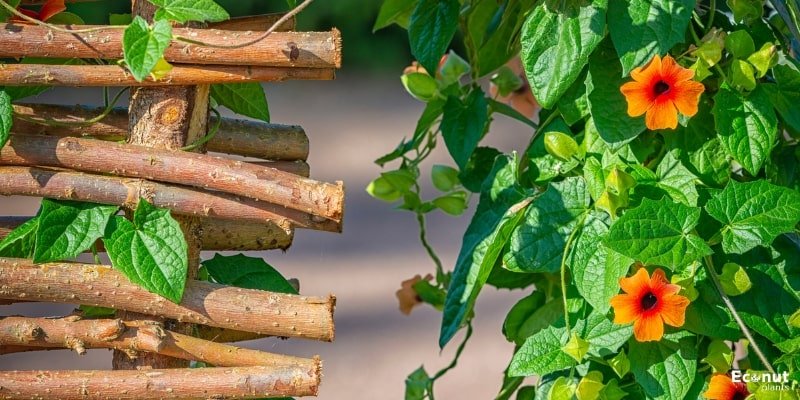
Scientific name: Thunbergia alata
Plant Type: Perennial
Plant Size: 3-8 feet
Sun Exposure: Partial shade to full sun
When most people think of the Black-Eyed Susan, they think of the shorter wildflower form rather than vining plants. A distinct kind of plant grows to a height of 8 feet and spreads to a maximum of 6 feet very quickly.
After the last frost, plant the vine in the early spring and watch it climb. In one growing season, it can reach a height of eight feet. The vine can take over its area of the garden if you’re not cautious, but it self-seeds, so you don’t need to bother about replanting or maintenance.
The little coral-coloured, daisy-like flowers are complemented by heart-shaped or arrowhead-shaped leaves. Also called a clock vine, it is considered invasive in some tropical regions, such as Hawaii, so research the plant before planting.
26. Chocolate Vine
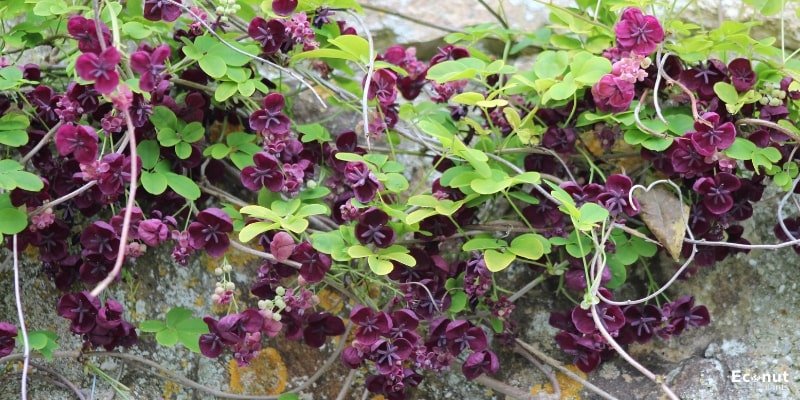
Scientific name: Akebia quinata
Plant Type: Perennial
Plant Size: 15-30 feet
Sun Exposure: Partial shade to full sun
The chocolate-scented blossoms on the Chocolate Vine are what give it its name; they are not the overly sweet-smelling blooms found on most other trellis-climbing vines. Compared to several other vines on our list, this one thrives in shadow.
Blooms differ from most other flowers in that they have three petals and a deep brownish-purple colour. They emerge in March and continue to bloom through May. Occasionally, they will yield small, edible but disagreeable-tasting fruits that resemble eggplants and contain dozens of tiny black seeds.
The glossy, dark green, oval-shaped leaves on this vine, which may grow up to 20 feet a year, are arranged in five-leaf clusters.
27. Scarlet Runner Bean
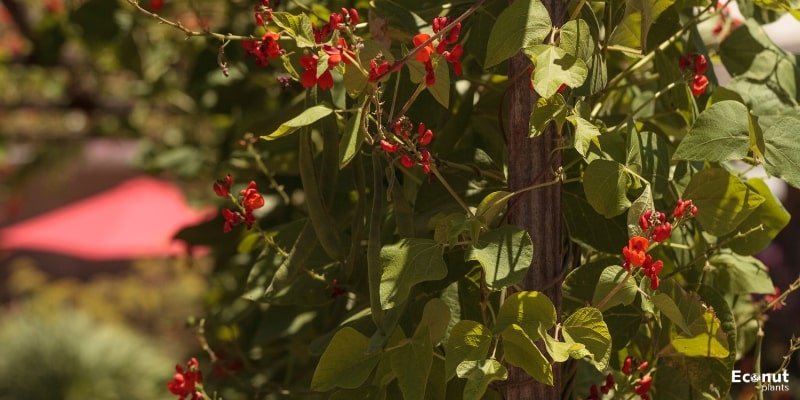
Scientific name: Phaseolus coccineus
Plant Type: Perennial
Plant Size: 8-20 feet
Sun Exposure: Partial to full sun
The flowers, which appear two months into the growing season, are white or red and are framed by clusters of three bright green leaves. 20-inch-long blossoms emerge from the initial deep-coloured buds that resemble flowers.
In late summer, bean pods can dangle up to a foot long and contain six to ten seeds per sprout. Though their texture is harsh and fibrous, immature pods can be eaten in moderation. As a decorative plant rather than for the beans, most people grow this vine.
28. Climbing Hydrangea

Scientific name: Hydrangea anomala petiolaris
Plant Type: Perennial
Plant Size: 30-50+ feet
Sun Exposure: Full shade to full sun
The climbing hydrangea requires little care and is simple to cultivate. It can act as a ground cover and is a good climber. It climbs slowly, using its tiny, aerial rootlets to cling to trees and even walls. Once established, though, the plant grows quickly.
The glossy dark green leaves provide a lovely background for the early-summer lace-cap blooms, which are white and cream in colour. It is poisonous to horses, cats, and dogs, so plant it somewhere that animals can’t easily get it.
29. Cypress Vine
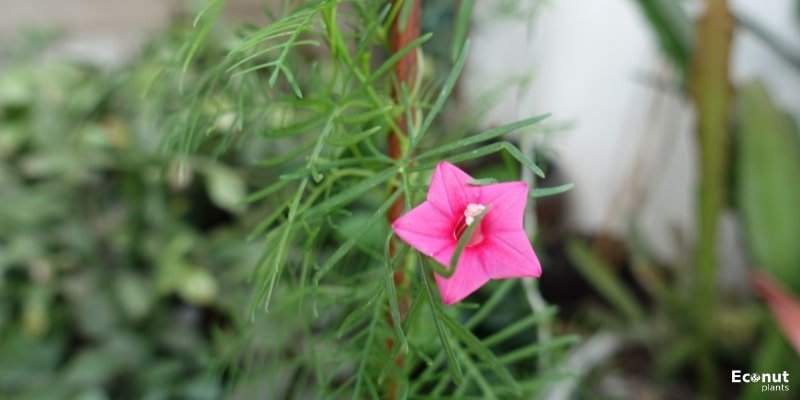
Scientific name: Ipomoea quamoclit
Plant Type: Annual
Plant Size: 3-6 feet
Sun Exposure: Full sun
The morning glory and the cypress vine are connected. It is also known as the Red Cypress Vine and the Hummingbird Vine. It’s a fantastic option if you wish to attract butterflies and hummingbirds to your garden or yard.
This annual vine bears star-shaped white, pink, or red flowers that bloom all summer. The flowers appear approximately a month after the earth warms and the vine begins to climb for the season. The plant often comes back each year if enough seeds are dropped and there is either no frost or very little frost in the area.
30. Star Jasmine

Scientific name: Trachelospermum jasminoides
Plant Type: Perennial
Plant Size: 3-6 feet
Sun Exposure: Partial shade to full sun
Even though Star Jasmine is a shorter vine, don’t let that stop you from admiring it because it doesn’t grow very tall. But its beauty more than compensates for its lack of height.
The leaves are lovely throughout the year, but tiny white flowers only develop in late spring or early summer. The stems are covered in oblong, brilliant green leaves that also function as an effective ground cover. Though it won’t produce as many blossoms, this vine is easy to cultivate and does well in the shade.
31. Sweetpea Vine

Scientific name: Lathyrus latifolius
Plant Type: Perennial
Plant Size: 6-10 feet
Sun Exposure: Full sun
This vine, often called the Everlasting or Perennial Sweetpea, has long peduncles that hold vivid flowers. It uses tendrils to climb flat surfaces, but it prefers to climb up trees or fences. The sweetpea serves as a ground covering as well.
Sweetpeas are pest-free and quite simple to grow. A favourite in gardening, the vine can yield blossoms in colours such as lavender, pink, red, blue, and white. It is hazardous, but only when consumed in high quantities, to both humans and pets.
Conclusion
Be mindful that many of the most beautiful flowers may be classified as invasive species in your state; research this before planting and proceed with caution. That being said, if you provide them with the proper growing conditions, they will thrive and provide you with the gorgeous blooms you want to climb your pergola or trellis.
Though perennials frequently die off over the winter and must be handled as annuals, the majority of these vines can be grown outside of the suggested plant zones.

